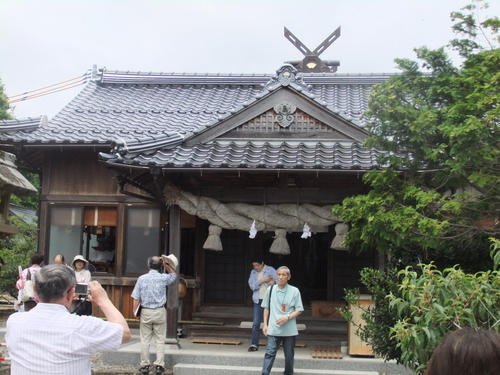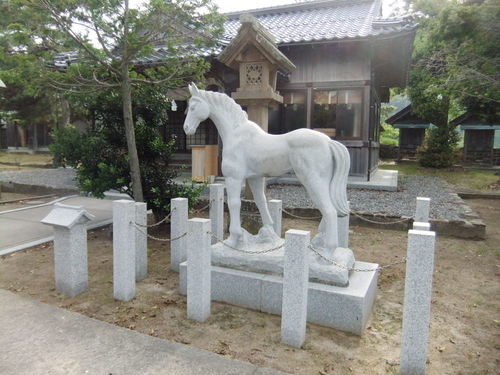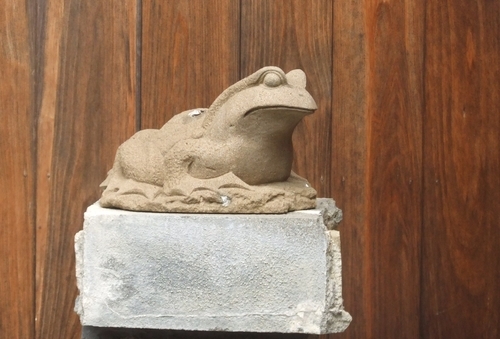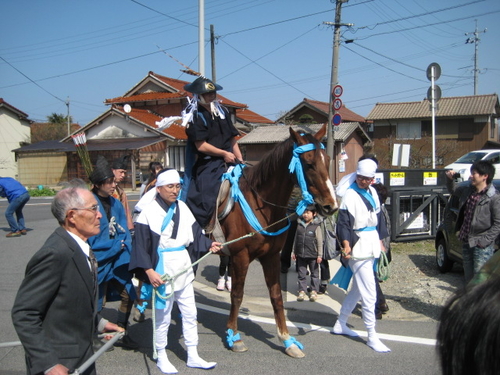Chikumi-ura
| Bay Name | Chikumi-ura |
|---|---|
| Shrine Name | Sansya daimyoujin(Former) Nisa jinja(Current) |
| Deity |
Izanagi no mikoto Izanami no mikoto Tsukutsumi no kami |
| Location |
Matsue-shi Mihonosekicho Chikumi (Aza Date) |
Chikumi ura Sansha Daimyoujin
Moshio yaku hamabe no name o ama mo ko no urabenaru
Kumu ya momokumichikumi naru

Of all the beach bays on the northern coast of the Shimane peninsula, Chikumi carried the most importance in ancient times. The Izumo no kuni Fudoki describes Chikumi as a passageway to the Oki islands. According to the Fudoki, “There is a pine grove to the east, a posting station to the south, and dwellings in the north.” It also states, “ Tsukutsumi, a descendant of Izanagi is enshrined there.”
The ‘Izumo Fudoki sho’, compiled at the start of the Edo era by Kishizaki Tokiteru directly links the former shrine name ‘Sansho jinja’ to the Nisa yashiro listed in the Fudoki. This connection has continued to present day and the shrine is worshipped at accordingly. Without a doubt, modern day Nisa-jinja was once Sansho-daimyoujin, but there is the possibility that today’s Nisa-jinja was actually in ancient times called Chikumi-yashiro and as touched on in the Sezaki-ura article, Hinomisaki-jinja on Sezaki was once ‘Nisa-yashiro’.
These kind of complicated developments that occurred in both history and in beliefs throw up tough challenges that require a lot of dedication and thought to unravel.
The ‘aza’ location on the north of Nisa-jinja is called ‘Date’. The former shrine chief at Sata-jinja, Asayama Akira suggested this was related to that area once being a posting station. Also of interest is the embankment that can be seen in the shrine grounds of Nisa-jinja. Upon passing under the Nisa-jinja shrine gate, taking the shrine road approach close by the Chikumi residences, one heads to the shrine walking towards the sea. Right there is a misunderstanding. In actual fact, the coast in front of Nisa-jinja faces east. Oki islands are towards the north on the left hand side, way off in the distance.
A plaque bearing the 42 bay pilgrimage verses can be seen through the glass doors of the main hall of the shrine. One is also reminded of the history of Chikumi as a former posting station on seeing the stone statue of a horse, donated to the shrine in recent years.

Within the shrine grounds of Nisa jinja, to the right of the hall of worship, is a 2 x 1.5m stone statue of a Yabusame (mounted archery) sacred horse. An annual horseback archery event is held around the vicinity of Nisa shrine in the afternoon of April 3rd.
While the yabusame archery of Tsuwano cho and Shima cho on Oki island is well known, the yabusame of Nisa also has a long history going back 450 years. It involves a youth on horseback going around the town firing an arrow at a target on a bamboo to bring town development and good health to the residents. After the ritual is completed, children can take a ride on the horse, an experience that is no doubt long treasured.
Furthermore, following the archery, in the hall of worship, two of the horseback riders perform an offertory Sumo bout as a prayer asking for the yabusame to return the following year. The fight involves each side winning one round each , the third being a draw. It is said to be similar to the sumo that takes place on Oki island. Sumo itself is said to be a ritual that requires a divine will to succeed. Indeed, the sumo tournament is a Shinto act performed in honor of the emperor, bringing to mind the ‘Tenran Zumo’ during modern day tournaments when the Emperor watches in person.
In front of the kami (deity) in the hall of worship is an offertory board with the words ‘Izumo forty two bay and salt purification verses’. This board is an updated version after the former one showed signs of aging.
Nisa shrine is an all year round purification spot where participants bring an offering of seaweed after submerging themselves in the nearby morning waters. While the purification here isn’t quite at the level of strictness as that of Miho jinja where food must not be consumed until ablutions are completed, there is no mistaking the similarities in the salt purification rites.
Every January 6th is the Otaue (rice planting) ceremony. In Nisa shrine, the farming implement is in the form of a ‘nusa’ Shinto paper streamer. If seawater is touched, one leaves the shrine, crosses the road and heads out to the sandy beach.


| Bay Name | Chikumi-ura |
|---|---|
| Shrine Name | Sansya daimyoujin(Former) Nisa jinja(Current) |
| Deity |
Izanagi no mikoto Izanami no mikoto Tsukutsumi no kami |
| Location |
Matsue-shi Mihonosekicho Chikumi (Aza Date) |
Chikumi ura Sansha Daimyoujin
Moshio yaku hamabe no name o ama mo ko no urabenaru
Kumu ya momokumichikumi naru
Of all the beach bays on the northern coast of the Shimane peninsula, Chikumi carried the most importance in ancient times. The Izumo no kuni Fudoki describes Chikumi as a passageway to the Oki islands. According to the Fudoki, “There is a pine grove to the east, a posting station to the south, and dwellings in the north.” It also states, “ Tsukutsumi, a descendant of Izanagi is enshrined there.”
The ‘Izumo Fudoki sho’, compiled at the start of the Edo era by Kishizaki Tokiteru directly links the former shrine name ‘Sansho jinja’ to the Nisa yashiro listed in the Fudoki. This connection has continued to present day and the shrine is worshipped at accordingly. Without a doubt, modern day Nisa-jinja was once Sansho-daimyoujin, but there is the possibility that today’s Nisa-jinja was actually in ancient times called Chikumi-yashiro and as touched on in the Sezaki-ura article, Hinomisaki-jinja on Sezaki was once ‘Nisa-yashiro’.
These kind of complicated developments that occurred in both history and in beliefs throw up tough challenges that require a lot of dedication and thought to unravel.
The ‘aza’ location on the north of Nisa-jinja is called ‘Date’. The former shrine chief at Sata-jinja, Asayama Akira suggested this was related to that area once being a posting station. Also of interest is the embankment that can be seen in the shrine grounds of Nisa-jinja. Upon passing under the Nisa-jinja shrine gate, taking the shrine road approach close by the Chikumi residences, one heads to the shrine walking towards the sea. Right there is a misunderstanding. In actual fact, the coast in front of Nisa-jinja faces east. Oki islands are towards the north on the left hand side, way off in the distance.
A plaque bearing the 42 bay pilgrimage verses can be seen through the glass doors of the main hall of the shrine. One is also reminded of the history of Chikumi as a former posting station on seeing the stone statue of a horse, donated to the shrine in recent years.
Within the shrine grounds of Nisa jinja, to the right of the hall of worship, is a 2 x 1.5m stone statue of a Yabusame (mounted archery) sacred horse. An annual horseback archery event is held around the vicinity of Nisa shrine in the afternoon of April 3rd.
While the yabusame archery of Tsuwano cho and Shima cho on Oki island is well known, the yabusame of Nisa also has a long history going back 450 years. It involves a youth on horseback going around the town firing an arrow at a target on a bamboo to bring town development and good health to the residents. After the ritual is completed, children can take a ride on the horse, an experience that is no doubt long treasured.
Furthermore, following the archery, in the hall of worship, two of the horseback riders perform an offertory Sumo bout as a prayer asking for the yabusame to return the following year. The fight involves each side winning one round each , the third being a draw. It is said to be similar to the sumo that takes place on Oki island. Sumo itself is said to be a ritual that requires a divine will to succeed. Indeed, the sumo tournament is a Shinto act performed in honor of the emperor, bringing to mind the ‘Tenran Zumo’ during modern day tournaments when the Emperor watches in person.
In front of the kami (deity) in the hall of worship is an offertory board with the words ‘Izumo forty two bay and salt purification verses’. This board is an updated version after the former one showed signs of aging.
Nisa shrine is an all year round purification spot where participants bring an offering of seaweed after submerging themselves in the nearby morning waters. While the purification here isn’t quite at the level of strictness as that of Miho jinja where food must not be consumed until ablutions are completed, there is no mistaking the similarities in the salt purification rites.
Every January 6th is the Otaue (rice planting) ceremony. In Nisa shrine, the farming implement is in the form of a ‘nusa’ Shinto paper streamer. If seawater is touched, one leaves the shrine, crosses the road and heads out to the sandy beach.






